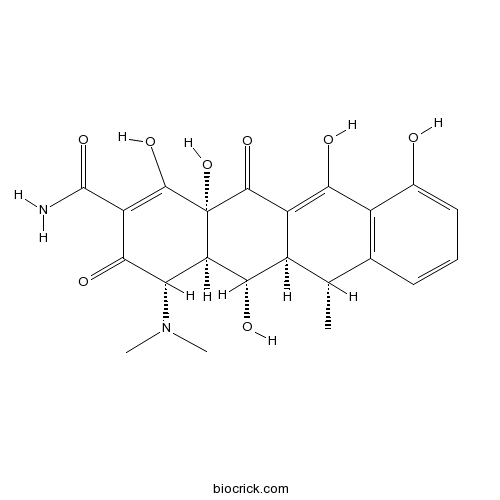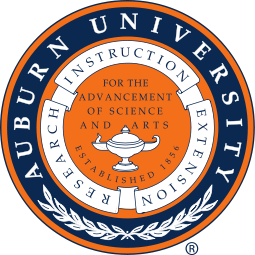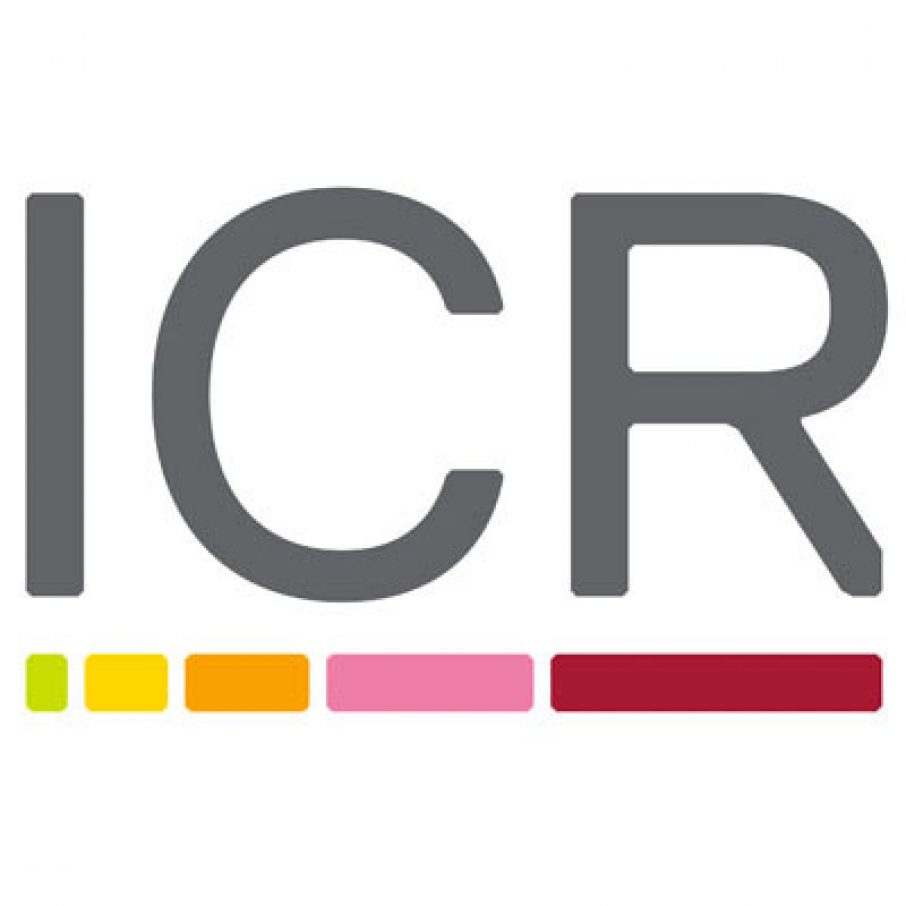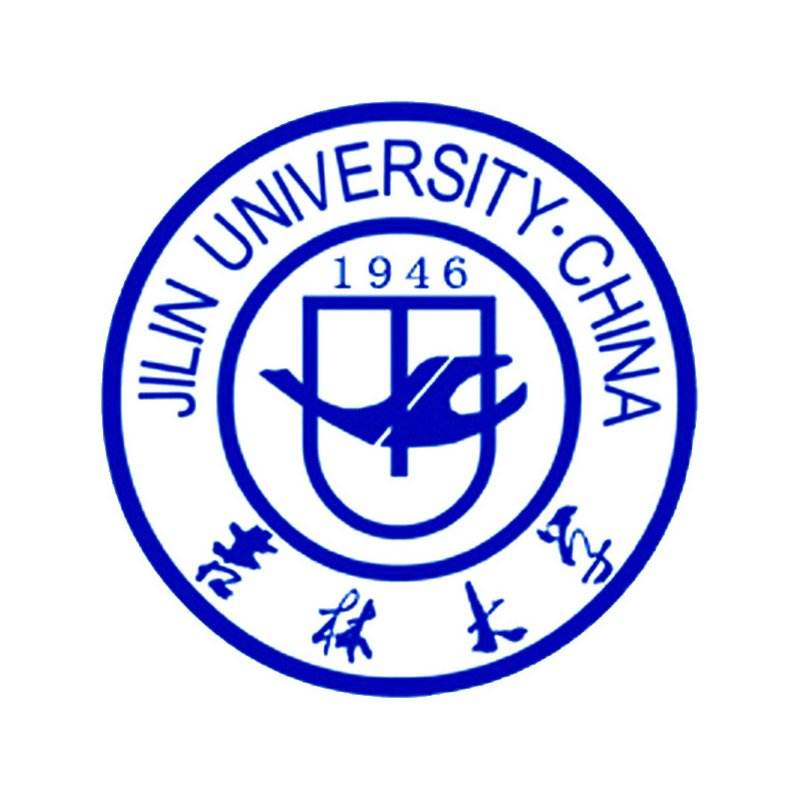DoxycyclineCAS# 564-25-0 |

Quality Control & MSDS
3D structure
Package In Stock
Number of papers citing our products

| Cas No. | 564-25-0 | SDF | Download SDF |
| PubChem ID | 54671203 | Appearance | Powder |
| Formula | C22H24N2O8 | M.Wt | 444.44 |
| Type of Compound | Miscellaneous | Storage | Desiccate at -20°C |
| Synonyms | Vibramycin;Doxiciclina | ||
| Solubility | Soluble in Chloroform,Dichloromethane,Ethyl Acetate,DMSO,Acetone,etc. | ||
| Chemical Name | (4S,4aR,5S,5aR,6R,12aR)-4-(dimethylamino)-1,5,10,11,12a-pentahydroxy-6-methyl-3,12-dioxo-4a,5,5a,6-tetrahydro-4H-tetracene-2-carboxamide | ||
| SMILES | CC1C2C(C3C(C(=O)C(=C(C3(C(=O)C2=C(C4=C1C=CC=C4O)O)O)O)C(=O)N)N(C)C)O | ||
| Standard InChIKey | SGKRLCUYIXIAHR-AKNGSSGZSA-N | ||
| Standard InChI | InChI=1S/C22H24N2O8/c1-7-8-5-4-6-9(25)11(8)16(26)12-10(7)17(27)14-15(24(2)3)18(28)13(21(23)31)20(30)22(14,32)19(12)29/h4-7,10,14-15,17,25-27,30,32H,1-3H3,(H2,23,31)/t7-,10+,14+,15-,17-,22-/m0/s1 | ||
| General tips | For obtaining a higher solubility , please warm the tube at 37 ℃ and shake it in the ultrasonic bath for a while.Stock solution can be stored below -20℃ for several months. We recommend that you prepare and use the solution on the same day. However, if the test schedule requires, the stock solutions can be prepared in advance, and the stock solution must be sealed and stored below -20℃. In general, the stock solution can be kept for several months. Before use, we recommend that you leave the vial at room temperature for at least an hour before opening it. |
||
| About Packaging | 1. The packaging of the product may be reversed during transportation, cause the high purity compounds to adhere to the neck or cap of the vial.Take the vail out of its packaging and shake gently until the compounds fall to the bottom of the vial. 2. For liquid products, please centrifuge at 500xg to gather the liquid to the bottom of the vial. 3. Try to avoid loss or contamination during the experiment. |
||
| Shipping Condition | Packaging according to customer requirements(5mg, 10mg, 20mg and more). Ship via FedEx, DHL, UPS, EMS or other couriers with RT, or blue ice upon request. | ||
| Description | 1. Doxycycline inhibits B cell, MC and histamine function and attenuates experimental allergic conjunctivitis and systemic anaphylaxis by possible modulating the PI3K/Akt pathway. 2. Doxycycline, an inhibitor of matrix metalloproteinases, has beneficial effects on sulfur mustard-induced ocular pathologies depend on the injury stage. 3. Doxycycline treatment of microfilaremic dogs gradually reduces numbers of microfilariae and blocks further transmission of heartworms, also has a slow-kill effect on adult heartworms. |
| Targets | TNF-α | IL Receptor | PI3K | Akt | NOS |

Doxycycline Dilution Calculator

Doxycycline Molarity Calculator
| 1 mg | 5 mg | 10 mg | 20 mg | 25 mg | |
| 1 mM | 2.25 mL | 11.2501 mL | 22.5002 mL | 45.0005 mL | 56.2506 mL |
| 5 mM | 0.45 mL | 2.25 mL | 4.5 mL | 9.0001 mL | 11.2501 mL |
| 10 mM | 0.225 mL | 1.125 mL | 2.25 mL | 4.5 mL | 5.6251 mL |
| 50 mM | 0.045 mL | 0.225 mL | 0.45 mL | 0.9 mL | 1.125 mL |
| 100 mM | 0.0225 mL | 0.1125 mL | 0.225 mL | 0.45 mL | 0.5625 mL |
| * Note: If you are in the process of experiment, it's necessary to make the dilution ratios of the samples. The dilution data above is only for reference. Normally, it's can get a better solubility within lower of Concentrations. | |||||

Calcutta University

University of Minnesota

University of Maryland School of Medicine

University of Illinois at Chicago

The Ohio State University

University of Zurich

Harvard University

Colorado State University

Auburn University

Yale University

Worcester Polytechnic Institute

Washington State University

Stanford University

University of Leipzig

Universidade da Beira Interior

The Institute of Cancer Research

Heidelberg University

University of Amsterdam

University of Auckland

TsingHua University

The University of Michigan

Miami University

DRURY University

Jilin University

Fudan University

Wuhan University

Sun Yat-sen University

Universite de Paris

Deemed University

Auckland University

The University of Tokyo

Korea University
- Sclareolide
Catalog No.:BCC6492
CAS No.:564-20-5
- Hop-17(21)-en-3-ol
Catalog No.:BCN5755
CAS No.:564-14-7
- UK-5099
Catalog No.:BCC2021
CAS No.:56396-35-1
- Metoprolol Tartrate
Catalog No.:BCC4330
CAS No.:56392-17-7
- Netilmicin Sulfate
Catalog No.:BCC4683
CAS No.:56391-57-2
- Epirubicin HCl
Catalog No.:BCC1192
CAS No.:56390-09-1
- Tirotundin
Catalog No.:BCN5754
CAS No.:56377-67-4
- Capillarisin
Catalog No.:BCN2461
CAS No.:56365-38-9
- Oxybutynin
Catalog No.:BCC3833
CAS No.:5633-20-5
- Hedychenone
Catalog No.:BCN5753
CAS No.:56324-54-0
- Conocarpan acetate
Catalog No.:BCN7584
CAS No.:56319-04-1
- Moracin M
Catalog No.:BCN3292
CAS No.:56317-21-6
- 11α-Hydroxyandrost-4-ene-3,17-dione
Catalog No.:BCC8432
CAS No.:564-33-0
- Hinokiol
Catalog No.:BCN5759
CAS No.:564-73-8
- Tetrahydrolachnophyllum lactone
Catalog No.:BCN4759
CAS No.:56407-87-5
- Methyl eichlerianate
Catalog No.:BCN5756
CAS No.:56421-12-6
- Eichlerianic acid
Catalog No.:BCN5757
CAS No.:56421-13-7
- 4,9-Dihydroxy-alpha-lapachone
Catalog No.:BCN5758
CAS No.:56473-67-7
- Steppogenin
Catalog No.:BCN5760
CAS No.:56486-94-3
- Angelic acid
Catalog No.:BCN3410
CAS No.:565-63-9
- 2-Hydroxy-3,4-dimethoxybenzoic acid
Catalog No.:BCN6535
CAS No.:5653-46-3
- Cyclo(Tyr-Pro)
Catalog No.:BCN2421
CAS No.:5654-84-2
- Cyclo(Pro-Leu)
Catalog No.:BCN2426
CAS No.:5654-86-4
- Cyclo(Pro-Val)
Catalog No.:BCN2420
CAS No.:5654-87-5
Effects of doxycycline on heartworm embryogenesis, transmission, circulating microfilaria, and adult worms in microfilaremic dogs.[Pubmed:25458121]
Vet Parasitol. 2014 Nov 15;206(1-2):5-13.
Tetracycline treatment of animals or humans infected with filariae that harbor Wolbachia endosymbionts blocks further embryogenesis, and existing microfilariae gradually die. This treatment also kills developing larvae and has a slow-kill effect on adult filariae, all presumably due to elimination of the Wolbachia. Also, Dirofilaria immitis microfilariae in blood collected from dogs up to 25 days after the last dose of Doxycycline developed to infective L3 that were normal in appearance and motility in mosquitoes but did not continue to develop or migrate normally after subcutaneous (SC) injection into dogs. The present study was designed to determine whether heartworm microfilariae collected at later times after treatment would regain the ability to continue normal development in a dog. The study also was expected to yield valuable data on the effects of treatment on microfilariae and antigen levels and adult worms. The study was conducted in 16 dogs as two separate replicates at different times. A total of five dogs (two in Replicate A and three in Replicate B) infected either by SC injection of L3 or intravenous transplantation of adult heartworms were given Doxycycline orally at 10mg/kg twice daily for 30 days, with three untreated controls. Microfilarial counts in the five treated dogs gradually declined during the 12-13 months after treatment initiation. Two dogs were amicrofilaremic before necropsy and three had 13 or fewer microfilariae/ml. Only one treated dog was negative for heartworm antigen before necropsy. Overall, treated dogs generally had fewer live adult heartworms than controls, and most of their live worms were moribund. All three control dogs remained positive for microfilariae and antigen and had many live worms. L3 from mosquitoes fed on blood collected 73-77 or 161-164 days after initiation of Doxycycline treatments were injected SC into five dogs. None of the dogs injected with L3 from mosquitoes fed on blood from Doxycycline-treated dogs were ever positive for microfilariae or antigen, and none had worms at necropsy; three control dogs were positive for microfilariae and antigen and had many live worms. These data indicate that Doxycycline treatment of microfilaremic dogs gradually reduces numbers of microfilariae and blocks further transmission of heartworms. This latter effect should be highly effective in reducing the rate of selection of heartworms with genes that confer resistance to macrocyclic lactone preventives and microfilaricides. The data also suggest that Doxycycline has a slow-kill effect on adult heartworms.
The beneficial effects of doxycycline, an inhibitor of matrix metalloproteinases, on sulfur mustard-induced ocular pathologies depend on the injury stage.[Pubmed:24502433]
Curr Eye Res. 2014 Aug;39(8):803-12.
PURPOSE: Sulfur mustard (SM) induces acute ocular lesions, including erosions and inflammation that may be followed by delayed injuries expressed by epithelial defects and neovascularization (NV). Based on the matrix metalloproteinases (MMPs) activity, we evaluated the clinical and biochemical effects of topical treatment with Doxycycline, an MMP inhibitor, targeted to the various injury stages. METHODS: Rabbit eyes were exposed to SM vapor. A clinical follow-up was carried out up to 2 months. Tear fluid and cornea samples were collected at different time points for measurements of MMPs activity by zymography. Efficacy of a post-exposure topical Doxycycline (2 mg/ml in phosphate buffer saline, x4/d), targeted to the different phases of the clinical injury, was evaluated. RESULTS: Elevated MMP-9 and MMP-2 activities were found in all corneas during the acute injury and in vascularized corneas during the delayed pathology. In the tear fluid, high MMP-9 activity and negligible MMP-2 activity were found in all the exposed eyes until after the appearance of the delayed pathology symptoms. Prolonged Doxycycline treatment reduced MMP-9 activity in the tear fluid. During the acute phase, Doxycycline treatment reduced corneal MMP-9 activity and the severity of the injury. Targeting the delayed pathology, Doxycycline was clinically efficient only when treatment began before NV appearance. CONCLUSIONS: This in vivo study showed the involvement of MMP-9 and MMP-2 during different phases of the SM-induced ocular injury, and the potential of Doxycycline treatment as a post exposure measure for reducing the acute injury and as a preventive therapy for ameliorating the delayed pathology. The tear fluid provided a non-invasive method for continuous follow-up of MMPs activity and revealed additional beneficial aspects of injury and the treatment.
Long-term outcomes of first-line treatment with doxycycline in patients with previously untreated ocular adnexal marginal zone B cell lymphoma.[Pubmed:25338969]
Ann Hematol. 2015 Apr;94(4):575-81.
Ocular adnexal lymphoma (OAL) has been associated with Chlamydophila psittaci infection, for which Doxycycline has been suggested as a treatment option. We conducted this study to evaluate the long-term results of first-line Doxycycline treatment in patients with OAL. Ninety patients with histologically confirmed OAL with marginal zone B cell lymphoma were enrolled. Each patient received one or two cycles of Doxycycline (100 mg bid) for 3 weeks. After a median follow-up period of 40.5 months (8-85), the 5-year progression-free survival (PFS) rate was 60.9 %. All patients were alive at the last follow-up date. Thirty-one patients (34 %) showed local treatment failure without systemic spread. However, PFS rate in these patients was 100 % after salvage chemotherapy and/or radiotherapy. PFS was independently predicted in multivariate analysis by the tumor-node-metastasis (TNM) staging (hazard ratio [HR], 4.35; 95 % confidence interval [CI], 2.03-9.32; P < 0.001) and number of cycles of Doxycycline (HR, 0.31; 95 % CI, 0.14-0.69; P = 0.004). No serious adverse event was reported during Doxycycline therapy. In conclusion, first-line Doxycycline therapy was effective and safe. Patients who failed to respond to Doxycycline therapy were successfully salvaged with chemotherapy and/or radiotherapy without compromising long-term outcomes. Patients with T1N0M0 disease could be considered good candidates for first-line Doxycycline.
Doxycycline exerts multiple anti-allergy effects to attenuate murine allergic conjunctivitis and systemic anaphylaxis.[Pubmed:25128381]
Biochem Pharmacol. 2014 Oct 1;91(3):359-68.
Allergic diseases, which affect up to 20-30% of the world population, are still therapeutic challenge for allergists. Tetracyclines, which belong to an antibiotic drug family that possesses a striking variety of non-antibiotic properties, have been successfully applied to a wide range of diseases. However, their roles in allergic conjunctivitis and anaphylaxis and their underlying anti-allergy mechanisms remain elusive. Here, we reported that treatment with Doxycycline significantly reduced IgE release from mouse B cells and the degranulation and inflammatory cytokines production of mouse mast cells (MCs) activated by IgE-dependent way. Furthermore, Doxycycline treatment significantly inhibited histamine-induced vascular hyperpermeability in vitro. Mechanistically, the Doxycycline-mediated inhibition of B cells, MCs and histamine may occur via modulation of the PI3K/Akt pathway. In vivo, our results demonstrated that treatment with Doxycycline significantly attenuated clinical symptoms of mouse models of experimental allergic conjunctivitis (EAC) with a significant decrease in inflammatory cell frequency, IgE production, histamine release, and a decrease in TNF-alpha and IL-4 production. Using mouse models of MCs-dependent passive systemic anaphylaxis (PSA), we further confirmed anti-allergy effects of Doxycycline and Doxycycline-mediated inhibitory effects on MCs. Furthermore, our results showed that Doxycycline significantly attenuate histamine-induced systemic anaphylaxis-like reaction (HISA) with a significantly downregulation of PI3K/Akt/eNOS/VE-cadherin pathway. The Doxycycline-mediated anti-allergy effects during EAC, PSA and HISA were abrogated when an Akt activator, SC79, was administered. These findings suggest that Doxycycline inhibits B cell, MC and histamine function and attenuates experimental allergic conjunctivitis and systemic anaphylaxis by possible modulating the PI3K/Akt pathway.


